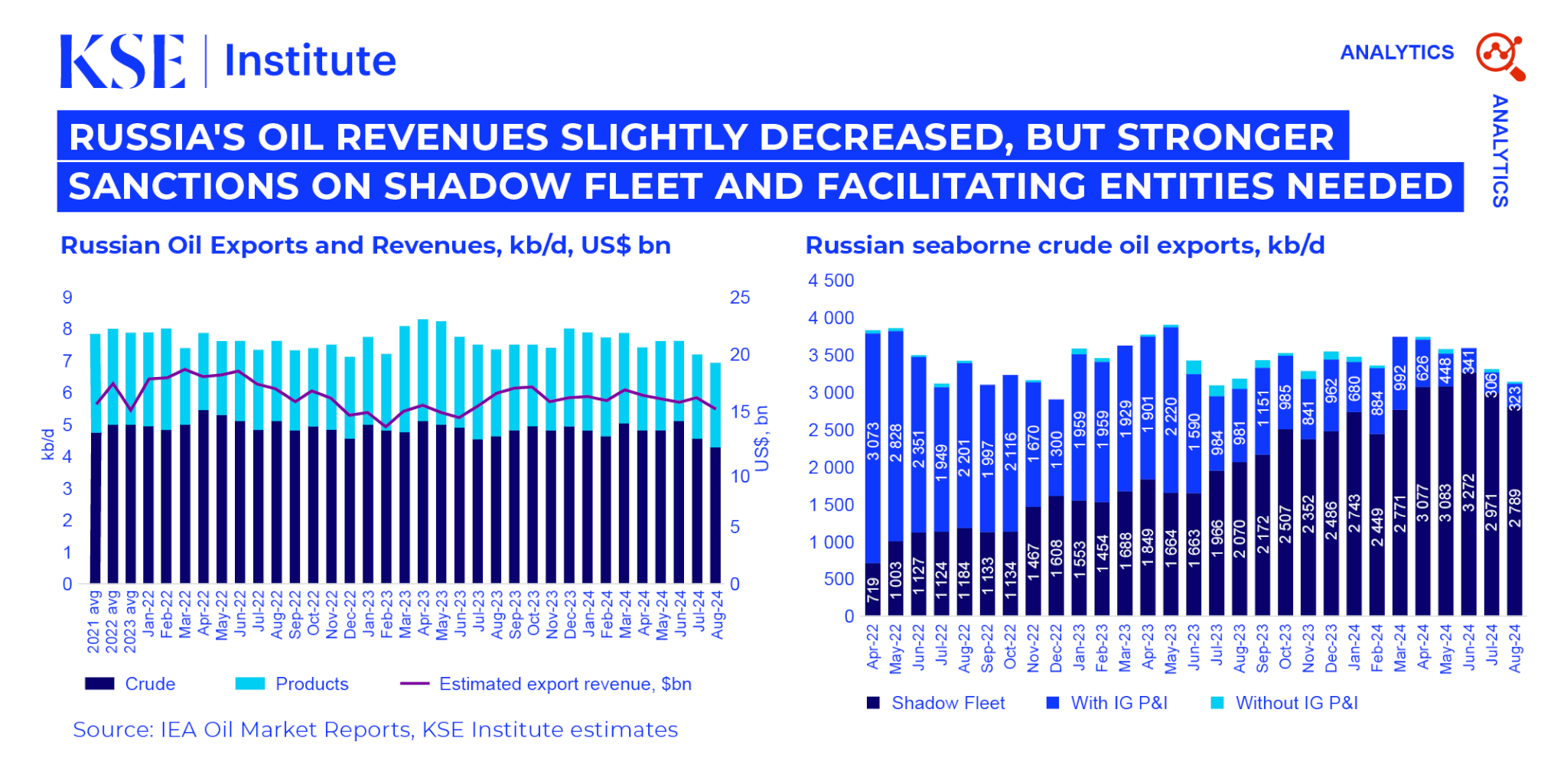- Kyiv School of Economics
- About the School
- News
- Russian Oil Tracker September 2024: Russia’s Oil Revenues Slightly Decreased, but Stronger Sanctions on Shadow Fleet and Facilitating Entities Needed*
Russian Oil Tracker September 2024: Russia’s Oil Revenues Slightly Decreased, but Stronger Sanctions on Shadow Fleet and Facilitating Entities Needed*
3 October 2024

*September issue temporarily covers crude oil only
In August 2024, Russian oil export revenues fell to $15.3 billion due to lower prices and the lowest export volumes since the invasion, according to the KSE Institute’s September ‘Russian Oil Tracker.’ Despite increased coalition sanctions on shadow fleet vessels, Russia continues testing these measures and seeks ways to bypass them.
Russian seaborne crude exports decreased by 5.3% MoM in August 2024, with only 10% covered by IG P&I insurance. Coverage varied by port: 17% from Baltic ports, 16% from the Black Sea, 2% from the Pacific, and none from the Arctic had insurance.
For other shipments of crude oil, Russia heavily relies on its shadow fleet. In August 2024, 107 loaded shadow tankers left Russian ports, with 2 involved in STS transfers. Notably, 87% of these vessels were over 15 years old. These poorly maintained and uninsured tankers pose a high environmental risk, significantly increasing the likelihood of oil spills—disasters for which Russia would likely refuse to pay.
The US, EU, and UK continue to implement a targeted strategy against the shadow fleet, effectively removing vessels from commercial operations. As of September 25, 74 tankers were sanctioned for transporting Russian oil, with the UK adding 10 more in September. Russia tested these measures, with 15 of the sanctioned tankers returning to service after long periods of inactivity, while others were withdrawn from operations.
Top importers continue to sustain demand for Russian oil, contributing significantly to Russia’s export revenues. In August 2024, India’s seaborne crude imports from Russia fell by 14.8% to 1,628 kb/d, yet the country remained the largest buyer. Imports to China, the second-largest buyer, rose by 4.9% to 1,175 kb/d. Meanwhile, imports to Turkey, the third-largest buyer, dropped by 21.1% MoM and 55.6% since June, reaching just 198 kb/d—the lowest since August 2023.
UAE and Chinese ship managers continue aiding Russia in bypassing sanctions. Stream Ship Management Fzco led Russian seaborne crude shipments in August, handling 19% of exports. Five Chinese firms accounted for 13%, while 11 Turkish and 5 Indian ship managers began lifting Russian crude in 2024 for the first time.
In August, oil export prices declined, with Urals FOB Primorsk and Novorossiysk dropping by ~$3.5 per barrel and $4.0 per barrel respectively to $68 per barrel, while ESPO FOB Kozmino fell by $5.7 per barrel to $72 per barrel. Despite the price drop, Urals remains $8 above the EU/G7 price cap of $60 per barrel. Moreover, discounts on Urals FOB Primorsk and Novorossiysk to ICE Brent narrowed by $1.5 per barrel and $1.0 per barrel to $10.5 per barrel and $10.6 per barrel respectively, the lowest since the invasion.
KSE Institute projects Russian oil revenues to reach $182 billion and $135 billion in 2024 and 2025 under the base case with current oil price caps and stronger sanctions enforcement. However, if sanctions enforcement is weak, Russian oil revenues could increase, reaching $189 billion in 2024 and $169 billion in 2025.
